Main content:
Latest Data on Major Global Challenges

Status November 2023
We provide a collection of latest data on major global challenges that result from limited access to vital resources (such as food, clean air or health care). Where possible, trend data was included, also in relation to targets of the UN Sustainable Development Goals (SDGs). Between their adoption in 2015 and the target year 2030, 2023 marks the end of the first half of the target period.
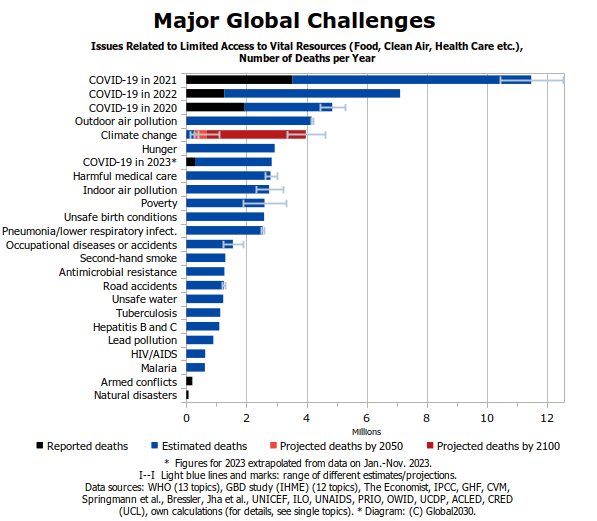
COVID-19
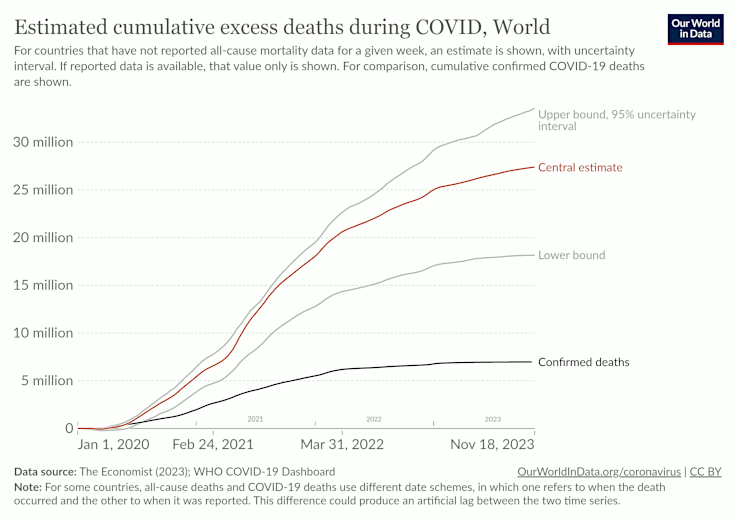 In total, the COVID-19 pandemic caused 6.98 million reported deaths by today (Nov. 2023), or an estimated 14.9 to 18.2 million deaths by the end of 2021, or 27.4 million by today (excess deaths).
In total, the COVID-19 pandemic caused 6.98 million reported deaths by today (Nov. 2023), or an estimated 14.9 to 18.2 million deaths by the end of 2021, or 27.4 million by today (excess deaths).
(To the regularly updated chart)
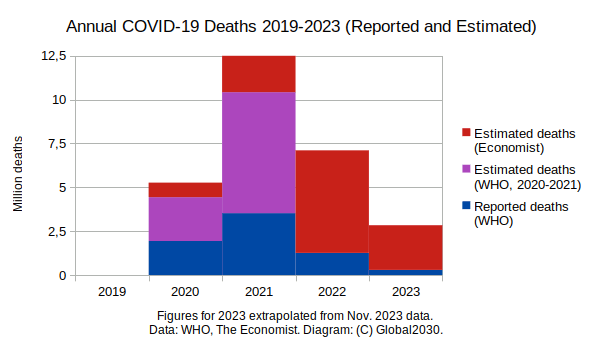 The annual death toll of COVID-19 rose from 4.44 to 5.27 million in 2020 to a peak of 10.4 to 12.5 million in 2021. Afterwards, it decreased to 7.11 million in 2022 and to 2.8 million in 2023 (extrapolated from 2.5 mn by Nov. 18) – still infectious killer no. 1.
The annual death toll of COVID-19 rose from 4.44 to 5.27 million in 2020 to a peak of 10.4 to 12.5 million in 2021. Afterwards, it decreased to 7.11 million in 2022 and to 2.8 million in 2023 (extrapolated from 2.5 mn by Nov. 18) – still infectious killer no. 1.
Mortality rates in Singapore, Japan and South Korea were much lower than in Western high-income countries.
Sources: WHO (reported deaths) (updated 8 November 2023), WHO (excess deaths), WHO (annual excess deaths), IHME/GBD study (excess deaths), The Economist (excess deaths, updated 18 November 2023).
Outdoor Air Pollution
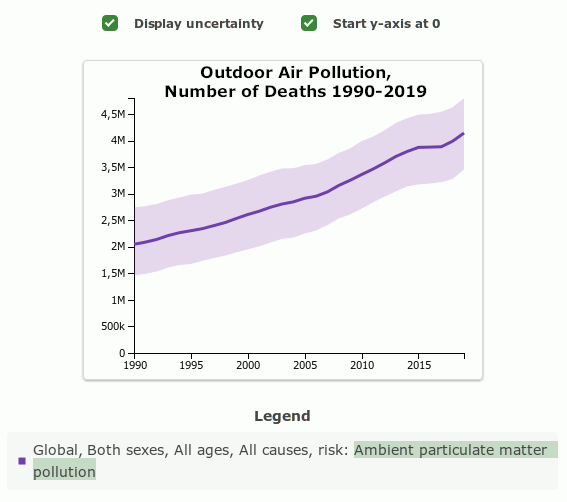 Outdoor air pollution led to about 4.14-4.2 million deaths globally in 2019. This figure is up from 3.87 million in 2015, which diverts from SDG 3.9 to substantially reduce the number of deaths from air pollution by 2030.
Outdoor air pollution led to about 4.14-4.2 million deaths globally in 2019. This figure is up from 3.87 million in 2015, which diverts from SDG 3.9 to substantially reduce the number of deaths from air pollution by 2030.
Sources: GBD study/IHME fact sheet, GBD study/IHME trend data and diagram (registration required), WHO.
Climate Change

By 2100, climate change is projected to result in a cumulative 83 million excess deaths (from 2020 to 2100). Most deaths are projected to occur at the end of the century, but they are caused by emissions today and throughout the century. At least 74 million deaths could be avoided by keeping global warming below 2.4° C.
Sources: WHO (on 2004, p. 50), WHO (on 2030 and 2050), IPCC, CVM 2, CVM 3 (p. 93), GHF (pp. 90, 87), Springmann et al. (p. 17), Bressler.
Hunger
 Undernourishment claimed the lives of around 2.94 million children in 2019. In 2022, 735 million people suffered from chronic hunger. That was 122 million people more than before the pandemic and 146 million more than in 2015. Therefore, the trend is contrary to the SDG 2 target to end hunger by 2030.
Undernourishment claimed the lives of around 2.94 million children in 2019. In 2022, 735 million people suffered from chronic hunger. That was 122 million people more than before the pandemic and 146 million more than in 2015. Therefore, the trend is contrary to the SDG 2 target to end hunger by 2030.
Sources: GBD study/IHME, FAO.
Harmful Medical Care
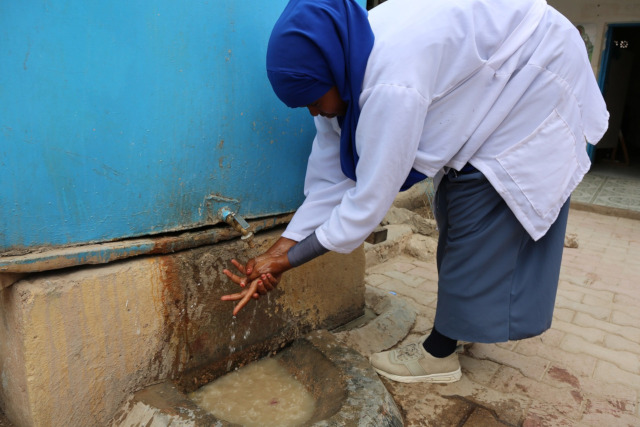 About 2.6-3 million deaths occur annually as a result of harmful medical care in low- and middle-income countries. Most of these are due to infections from unsafe equipment or procedures (insufficient hygiene).
About 2.6-3 million deaths occur annually as a result of harmful medical care in low- and middle-income countries. Most of these are due to infections from unsafe equipment or procedures (insufficient hygiene).
Sources: WHO, Jha et al. Photo: WHO/Ilyas Ahmed.
Indoor Air Pollution
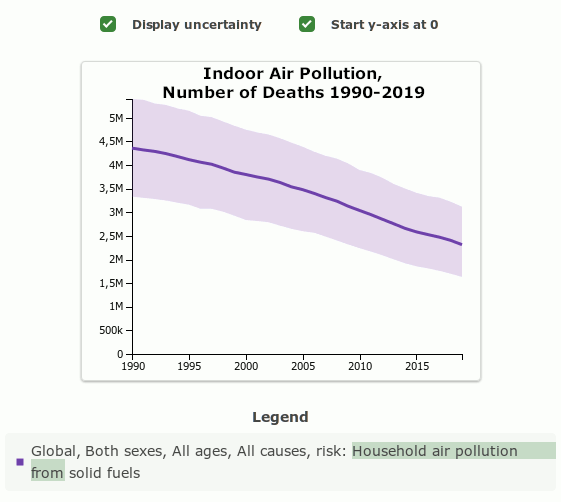 Indoor air pollution, resulting from burning solid fuels for cooking and heating, claimed the lives of 2.31 to 3.2 million people in 2019/2020. It fell from 2.58 million in 2015 to 2.31 million in 2019. Whether this complies with SDG target 3.9 to substantially reduce the number of deaths from air pollution by 2030 may depend on the understanding of "substantially".
Indoor air pollution, resulting from burning solid fuels for cooking and heating, claimed the lives of 2.31 to 3.2 million people in 2019/2020. It fell from 2.58 million in 2015 to 2.31 million in 2019. Whether this complies with SDG target 3.9 to substantially reduce the number of deaths from air pollution by 2030 may depend on the understanding of "substantially".
Sources: GBD study/IHME fact sheet, GBD study/IHME trend data and diagram (registration required), WHO.
Poverty
 Around 691 million people are living in extreme poverty (i.e. at a consumption level below $2.15 per day). This estimate for 2023 does not take into account current food price inflation. The figure fell from 800 million in 2015, but we are not on track to meet target SDG 1 to end poverty by 2030.
Around 691 million people are living in extreme poverty (i.e. at a consumption level below $2.15 per day). This estimate for 2023 does not take into account current food price inflation. The figure fell from 800 million in 2015, but we are not on track to meet target SDG 1 to end poverty by 2030.
Poverty contributes 23-51% to mortality from hunger, unsafe water/sanitation and indoor air pollution.
Sources: World Bank, WHO (pp. 1942, 2068-2069).
Unsafe Birth Conditions
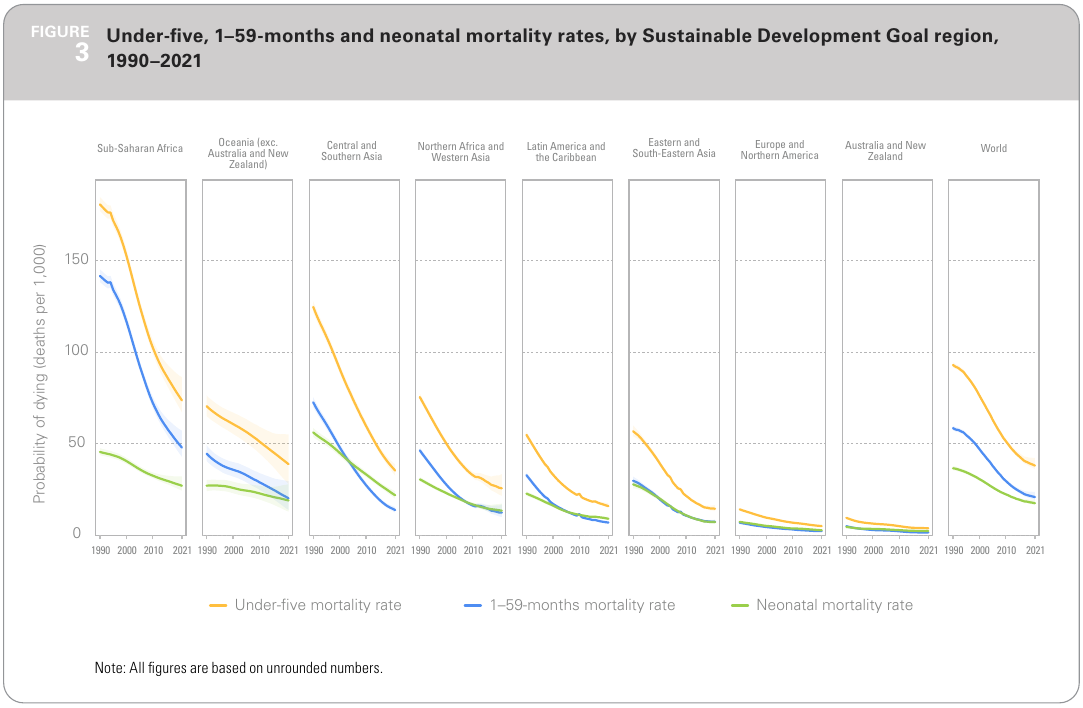 About 2.3 million newborns died in 2021, and 287,000 women died during pregnancy or childbirth in 2020. The neonatal mortality rate decreased from 20 deaths per 1000 live births in 2015 to 18 in 2021, but progress is not sufficient to reach SDG 3.2 target of 12 by 2030. The maternal mortality rate fell slightly from 227 deaths per 100,000 live births in 2015 to 223 in 2020, being off-track to meet SDG 3.1 target of 70 by 2030.
About 2.3 million newborns died in 2021, and 287,000 women died during pregnancy or childbirth in 2020. The neonatal mortality rate decreased from 20 deaths per 1000 live births in 2015 to 18 in 2021, but progress is not sufficient to reach SDG 3.2 target of 12 by 2030. The maternal mortality rate fell slightly from 227 deaths per 100,000 live births in 2015 to 223 in 2020, being off-track to meet SDG 3.1 target of 70 by 2030.
Source: UNICEF (deaths; target 3.2, p. 10; target 3.1).
Pneumonia
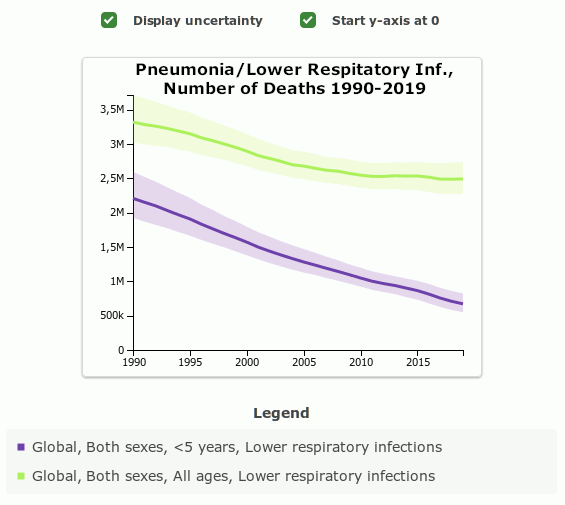 About 2.49 to 2.59 million people died from pneumonia and other lower respiratory infections (such as influenza or RSV) in 2019. Among those killed, 672,000 to 740,000 were children under the age of five. Trends are declining.
About 2.49 to 2.59 million people died from pneumonia and other lower respiratory infections (such as influenza or RSV) in 2019. Among those killed, 672,000 to 740,000 were children under the age of five. Trends are declining.
Sources: GBD study/IHME fact sheet, GBD study/IHME trend data and diagram (registration required), WHO.
Work-related Accidents
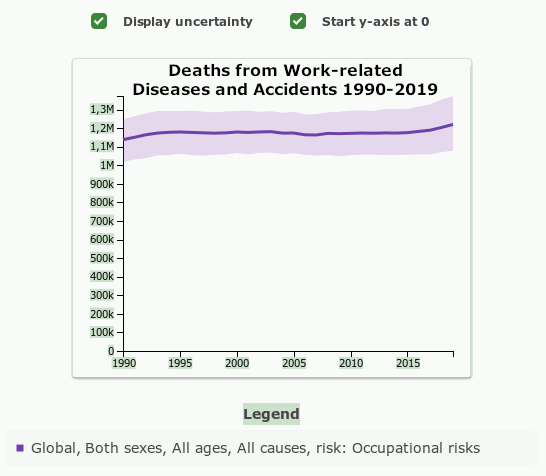 Between 1.22 and 1.88 million people die annually from occupational diseases or accidents. The trend is rising slightly, despite SDG 8.8 calls to promote safe and secure working environments for all workers.
Between 1.22 and 1.88 million people die annually from occupational diseases or accidents. The trend is rising slightly, despite SDG 8.8 calls to promote safe and secure working environments for all workers.
Sources: GBD study/IHME fact sheet, GBD study/IHME trend data and diagram (registration required), ILO (p. 59).
Passive Smoking
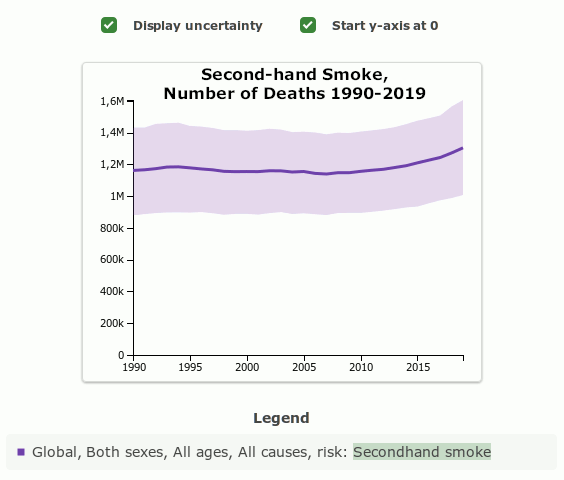 Second-hand smoke led to around 1.30 million deaths in 2019. This death toll has risen from 1.21 million in 2015.
Second-hand smoke led to around 1.30 million deaths in 2019. This death toll has risen from 1.21 million in 2015.
Sources: GBD study/IHME fact sheet, GBD study/IHME trend data and diagram (registration required), WHO.
Antimicrobial Resistance
 At least 1.27 million people died from antibiotic-resistant bacterial infections in 2019. Such infections contribute to many more deaths.
At least 1.27 million people died from antibiotic-resistant bacterial infections in 2019. Such infections contribute to many more deaths.
Source: GBD study/IHME. Photo: Rocky Mountain Laboratories, NIAID, NIH, USA.
Road Traffic Accidents
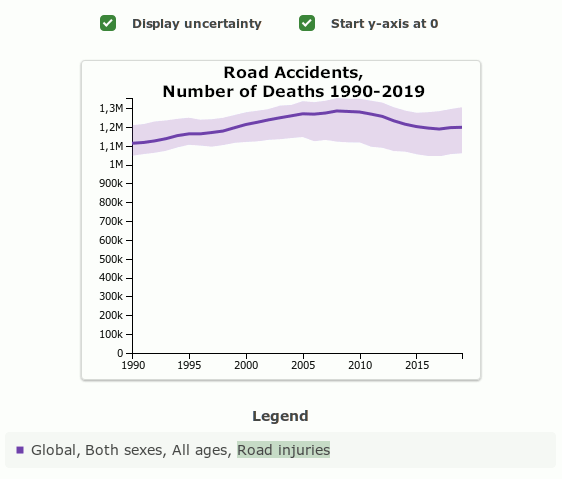 Road accidents cause 1.20-1.3 million fatalities per year. The latest figure relates to 2019 and was the same as in 2015, completely missing SDG 3.6 target to halve the number of global deaths from road traffic by 2020.
Road accidents cause 1.20-1.3 million fatalities per year. The latest figure relates to 2019 and was the same as in 2015, completely missing SDG 3.6 target to halve the number of global deaths from road traffic by 2020.
Sources: GBD study/IHME fact sheet, GBD study/IHME trend data and diagram (registration required), WHO.
Unsafe Water
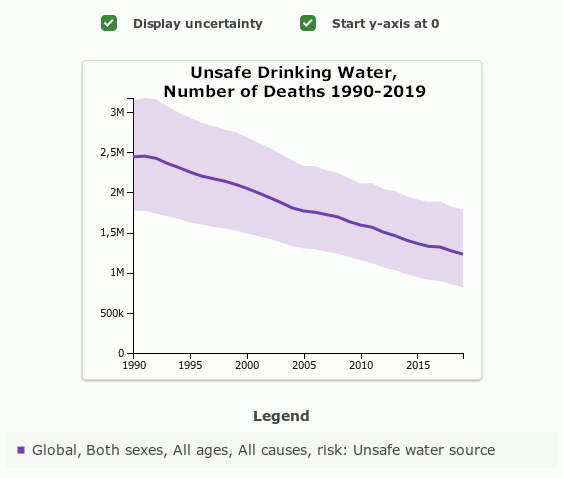 Unsafe water led to about 1.23 million deaths in 2019, mainly among children. This is a decrease from 1.36 million in 2015, which may or may not be in line with SDG 3.9 to "substantially reduce" the number of deaths from water pollution and contamination by 2030.
Unsafe water led to about 1.23 million deaths in 2019, mainly among children. This is a decrease from 1.36 million in 2015, which may or may not be in line with SDG 3.9 to "substantially reduce" the number of deaths from water pollution and contamination by 2030.
In 2022, 2.2 billion people lacked access to safely managed drinking water. Between 2015 and 2022, global coverage of safely managed drinking water increased from 69% to 73%. Progress is not sufficient to achieve SDG 6.1 target of universal access to safe water by 2030.
Sources: GBD study/IHME fact sheet, GBD study/IHME trend data and diagram (registration required), UNICEF (p. 14).
Tuberculosis
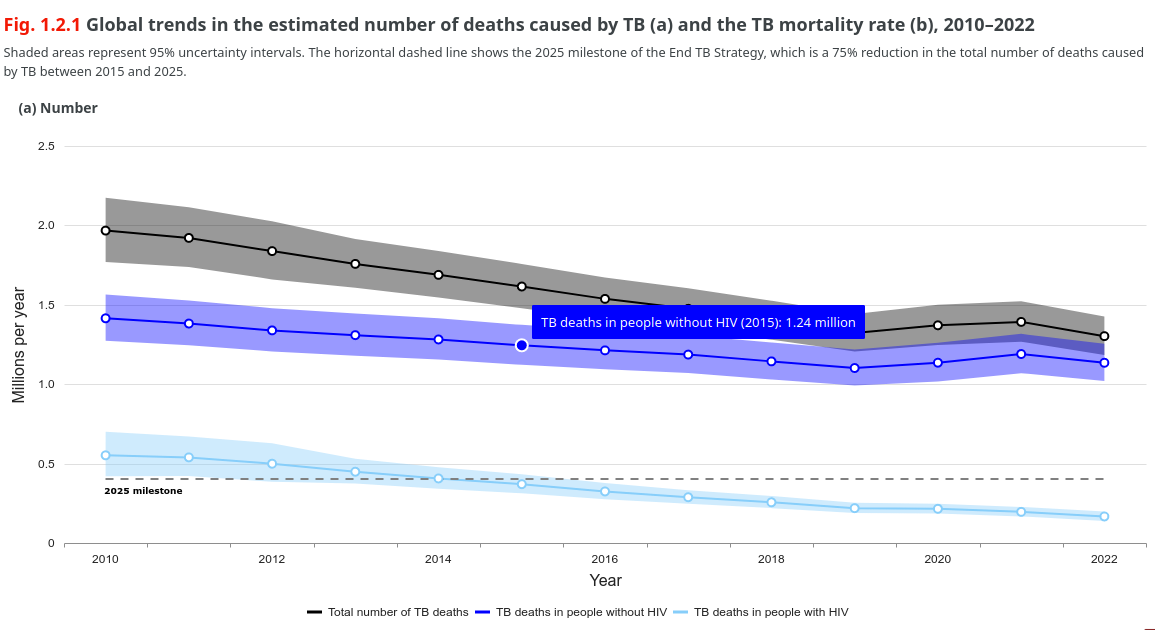 Tuberculosis caused about 1.13 million deaths in 2022 (not including the 167,000 people killed by AIDS with TB co-infection). That was down from 1.24 million deaths in 2015 but still not on track to meet SDG 3.3 target to end TB by 2030.
Tuberculosis caused about 1.13 million deaths in 2022 (not including the 167,000 people killed by AIDS with TB co-infection). That was down from 1.24 million deaths in 2015 but still not on track to meet SDG 3.3 target to end TB by 2030.
Sources: WHO, WHO on 2015 etc.
Hepatitis B and C
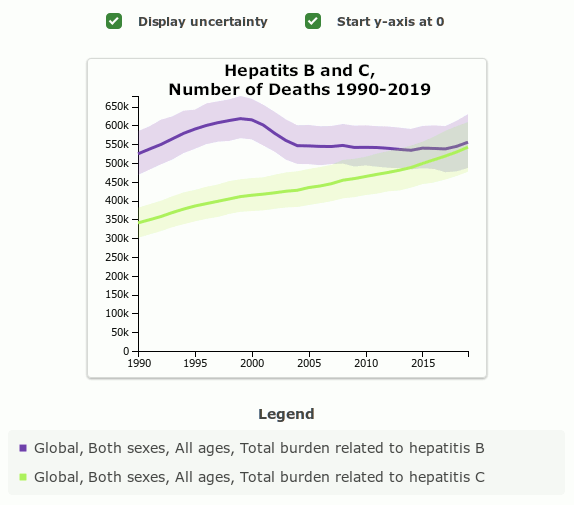 Hepatitis B and C resulted in around 1.1 million deaths in 2019, mainly through related cirrhosis and liver cancer. The trend is rising, despite SDG 3.3 to "combat hepatitis".
Hepatitis B and C resulted in around 1.1 million deaths in 2019, mainly through related cirrhosis and liver cancer. The trend is rising, despite SDG 3.3 to "combat hepatitis".
Sources: GBD study/IHME summary, GBD study/IHME trend data and diagram (registration required), WHO on hepatitis B, WHO on hepatitis C.
Lead Pollution
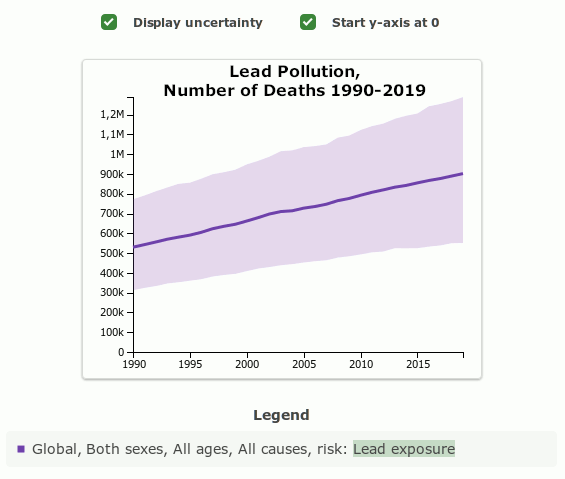 Lead pollution resulted in around 902,000 deaths in 2019. The death toll rose from 855,000 in 2015, deviating from SDG 3.9 to substantially reduce the number of deaths from hazardous chemicals and air, water and soil pollution by 2030.
Lead pollution resulted in around 902,000 deaths in 2019. The death toll rose from 855,000 in 2015, deviating from SDG 3.9 to substantially reduce the number of deaths from hazardous chemicals and air, water and soil pollution by 2030.
Sources: WHO, GBD study/IHME fact sheet, GBD study/IHME trend data and diagram (registration required).
HIV/AIDS
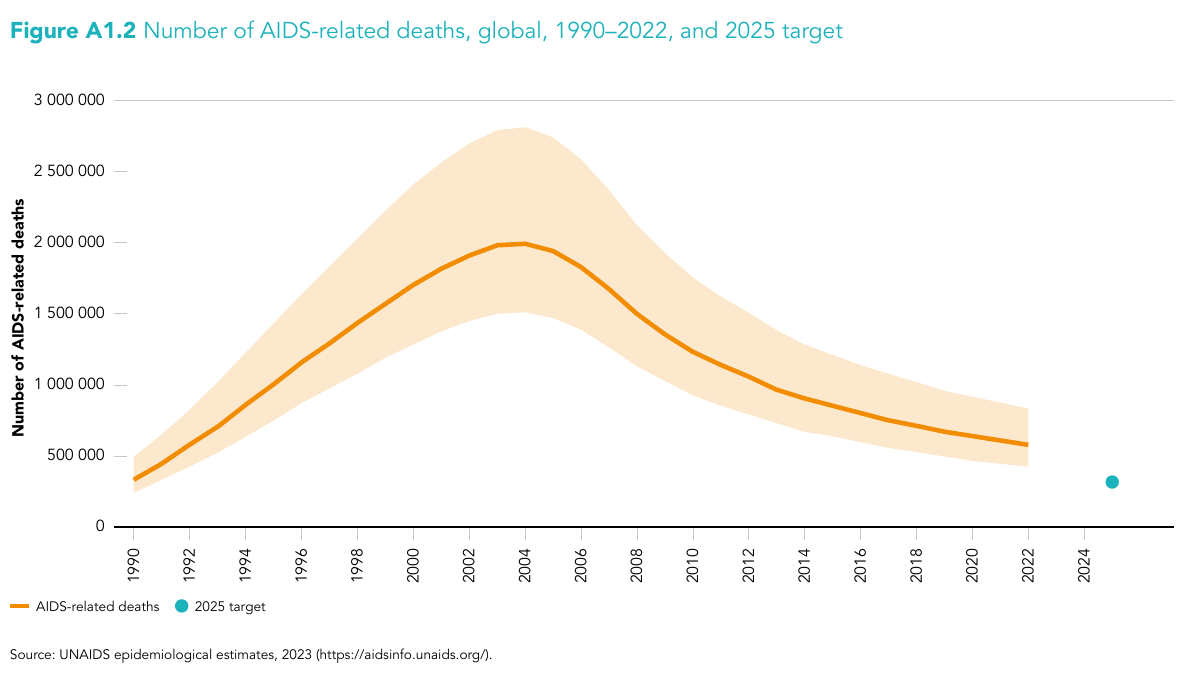 AIDS claimed about 630,000 lives in 2022. Although this number of deaths dropped from 900,000 in 2015, it may meet neither the 2025 UNAIDS target nor the 2030 SDG 3.3 target to end AIDS.
AIDS claimed about 630,000 lives in 2022. Although this number of deaths dropped from 900,000 in 2015, it may meet neither the 2025 UNAIDS target nor the 2030 SDG 3.3 target to end AIDS.
Sources: UNAIDS fact sheet, UNAIDS trend data.
Malaria
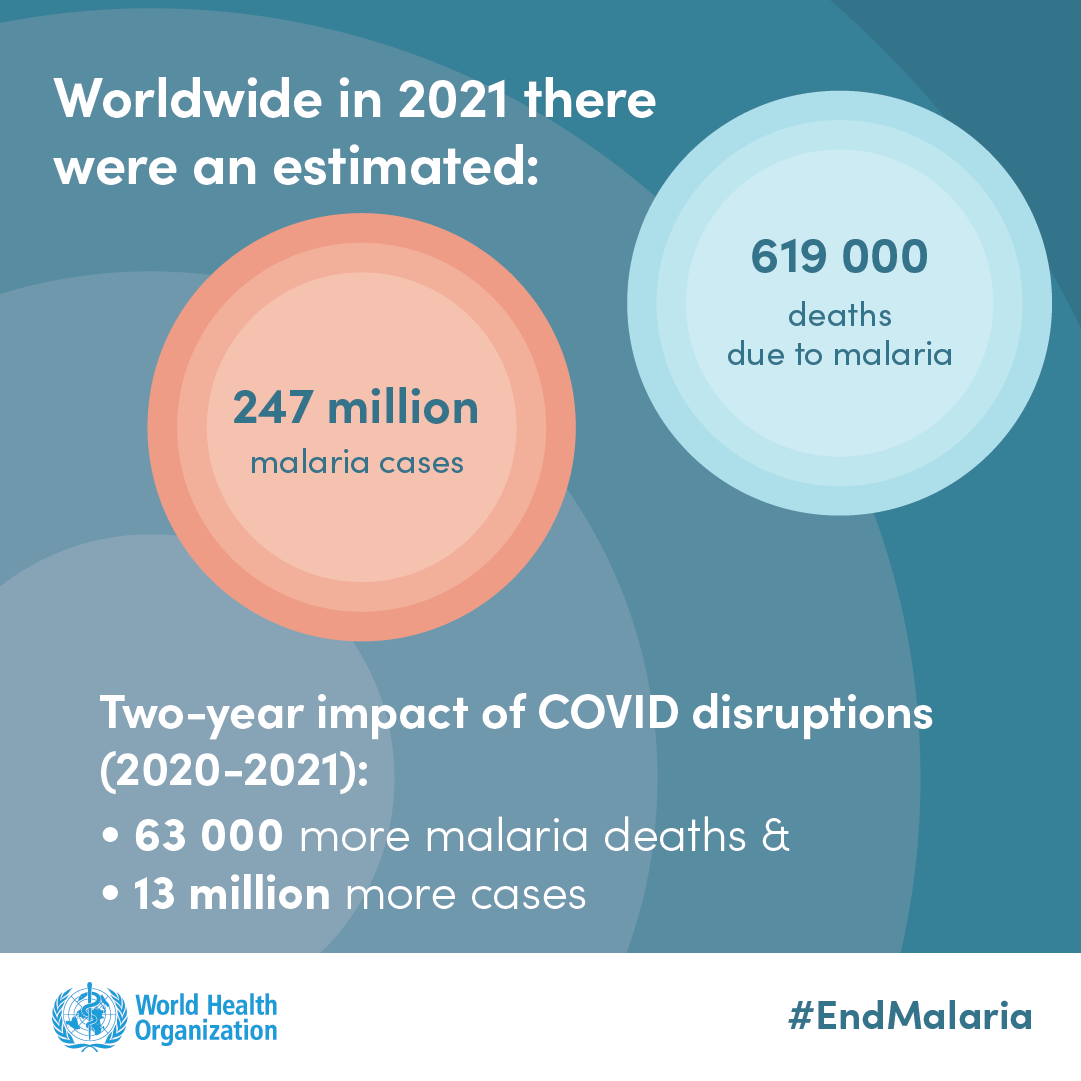 Malaria killed around 619,000 people in 2021, predominantly children. This figure has risen from 577,000 in 2020 as the pandemic has disrupted the provision of means to fight malaria. So far, we are not on track to meet SDG 3.3 target to end malaria by 2030.
Malaria killed around 619,000 people in 2021, predominantly children. This figure has risen from 577,000 in 2020 as the pandemic has disrupted the provision of means to fight malaria. So far, we are not on track to meet SDG 3.3 target to end malaria by 2030.
Source: WHO (p. 15).
Armed Conflicts
 Armed conflicts caused 204,000 reported battle deaths in 2022, including civilian casualties. This was by far the highest death toll for almost three decades. Most battle deaths occurred in Ethiopia (100,000) and Ukraine (81,500). Attacks directly targeting civilians led to 49,700 reported casualties (not including "collateral" civilian casualties). The increase of battle deaths negates the aim of SDG 16.1 to significantly reduce all forms of violence and related death rates everywhere.
Armed conflicts caused 204,000 reported battle deaths in 2022, including civilian casualties. This was by far the highest death toll for almost three decades. Most battle deaths occurred in Ethiopia (100,000) and Ukraine (81,500). Attacks directly targeting civilians led to 49,700 reported casualties (not including "collateral" civilian casualties). The increase of battle deaths negates the aim of SDG 16.1 to significantly reduce all forms of violence and related death rates everywhere.
Sources: PRIO, OWID, UCDP, ACLED.
Natural Disasters
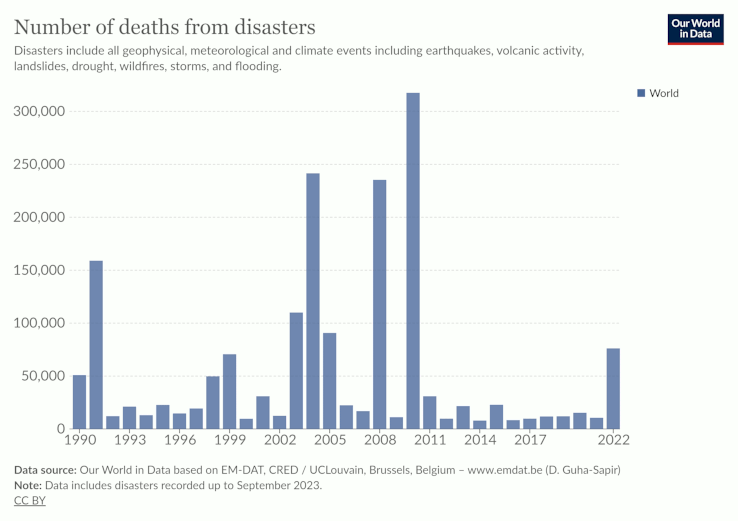 Natural disasters caused 76,125 reported deaths in 2022. This included more than 61,000 excess deaths resulting from at least five record-breaking heatwaves in Europe. In its World Disaster Report 2022, the International Federation of Red Cross and Red Crescent Societies (IFRC) also included the COVID-19 pandemic as one of the biggest disasters in living memory. Even if excluding the pandemic, the death toll has risen sharply from 22,874 reported deaths in 2015, which is not in line with SDG 11.5 to significantly reduce the number of deaths caused by disasters by 2030.
Natural disasters caused 76,125 reported deaths in 2022. This included more than 61,000 excess deaths resulting from at least five record-breaking heatwaves in Europe. In its World Disaster Report 2022, the International Federation of Red Cross and Red Crescent Societies (IFRC) also included the COVID-19 pandemic as one of the biggest disasters in living memory. Even if excluding the pandemic, the death toll has risen sharply from 22,874 reported deaths in 2015, which is not in line with SDG 11.5 to significantly reduce the number of deaths caused by disasters by 2030.
Sources: OWID, CRED, IFRC.
Conclusion
Among these 21 major global challenges arising from limited access to vital resources, 10 have worsened and 8 have improved since 2015 (one challenge has not changed and no trend data is available for two challenges). The Sustainable Development Goals (SDGs) contain time-bound and quantifiable targets for 12 of these topics. None of these targets are clearly on track to be met by their target year (most often 2030). For two targets, the assessment may depend on the interpretation of what it means to reduce a problem "substantially". As we pass the midpoint of the SDG target period, the SDGs still need a booster.
 As a consequence of various global challenges, about 108 million people were displaced at the end of 2022. Of these, 62.5 million were displaced within their home country. Most refugees came from Syria (6.5 million), Ukraine and Afghanistan (each 5.7 mn). About 76% of refugees were hosted in low- and middle-income countries. The countries hosting most refugees were Turkey (3.6 mn), Iran (3.4 mn), Colombia (2.5 mn) and Germany (2.1 mn).
As a consequence of various global challenges, about 108 million people were displaced at the end of 2022. Of these, 62.5 million were displaced within their home country. Most refugees came from Syria (6.5 million), Ukraine and Afghanistan (each 5.7 mn). About 76% of refugees were hosted in low- and middle-income countries. The countries hosting most refugees were Turkey (3.6 mn), Iran (3.4 mn), Colombia (2.5 mn) and Germany (2.1 mn).
Worldwide, there were around 281 million migrants in 2020 (people living in a country other than they were born). They transferred 540 billion U$ in remittances to low- and middle income countries of origin in 2020 – more than three times the official development assistance (172 billion U$ in 2020).
Sources: UNHCR, IOM (p. 3), OECD.
Suggested citation:
Global2030: Latest Data on Major Global Challenges; Status November 2023. Berlin, Global Challenges Initiative e.V., 2023. (www.global2030.net/news/global_challenges_data_2023.html).
